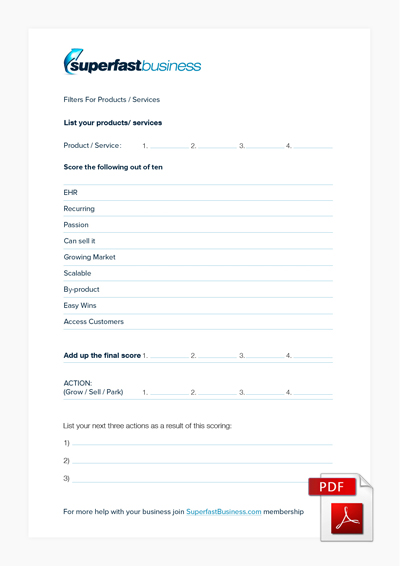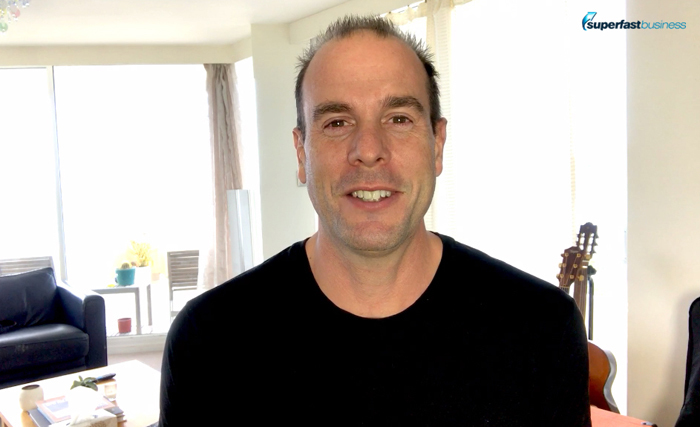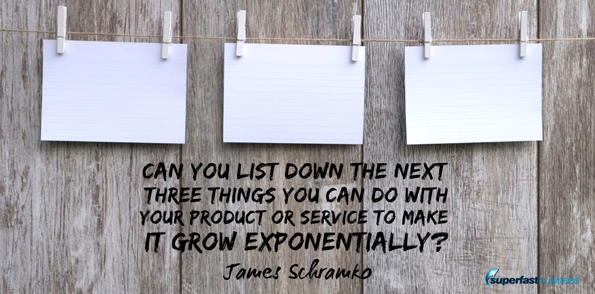Podcast: Download (Duration: 16:59 — 15.8MB)
Get Notified Of Future Episodes Apple Podcasts | Spotify | Amazon Music | Android | Blubrry | Gaana | TuneIn | Deezer | Anghami | RSS | More
Video highlights:
00:20 – Why so many projects?
02:29 – To diversify or not to diversify
05:01 – This should be your number one filter
06:31 – An obvious choice
07:32 – Passion is where it’s at
08:30 – Can you do THIS with your business?
09:05 – Is your market on the up?
10:29 – Consider scalability
11:23 – Leverage with by-products
12:11 – Are there easy wins?
13:09 – Can you get to your customers?
13:46 – Score your opportunities
14:28 – Your next course of action
Need a hand growing your business? James will coach you privately inside the JamesSchramko membership
Transcription:
James Schramko here from SuperFastBusiness.com. Today, I want to discuss with you which product or service should you be focusing on. Chances are you have a number of projects that you’re working on. And the very first thing that we should do is question, why have you got so many projects that you’re working on?
Are you a starter who likes to read an email, start a new challenge or a course, get into the first intro module or so and then stop? And then you go into the next one? Or are you just trying things because you have an idea and then you’re trying to monetize it, which is effectively putting the cart before the horse and you’re never making success with it so you start the next thing? Or maybe you’ve just got 15 things on the go because you have entrepreneurial ADD and you’re getting stuck.
Now over the years, I’ve tried a few different things. I went from having one job to having one job and then side jobs. And the main side job that worked for me was my online business. And when I went into my online business, I wasn’t exactly sure what I should do.
Now at this point, if you haven’t already seen it, I would refer you to my very popular post on SuperFastBusiness.com, which is all about Ikigai. Ikigai is finding your perfect sweet spot in life where you’re balancing out things that you’re good at, things that you can get paid for, things that you enjoy, etc. And that’s a deeper topic. So go and check that out if you haven’t already found that, if you’re still drifting around.
So when I started out online, I tried a few different things and eventually after trying a few different things, I found the thing that was going to be my first hundred thousand dollars’ worth of income as an affiliate and that was selling software. And it worked out for me. And then from there, I started all these different business models, and at one point, I had 12 different income streams. But as you know, you can get spread too thin.
Should you diversify?
Now I did it to diversify because I never wanted to run out of cash again, which I did the very first Christmas after I quit my job just because I effectively sent a company broke. I actually sold so much of their product they couldn’t deliver and they had to do refunds and then they didn’t pay me. So I started diversifying. But you can diversify too much.
“You can diversify too much.”
Now a big clue to how far you’re diversified is this. Are you in entirely different markets where you have a different customer? If you are, then you’re very diversified. Warren Buffett has some kind of a saying that talks about the fact that if you’re too diversified, it just means that you probably don’t know what you should be doing.
Now I’m generally dealing with one type of customer market but at different levels within that market. And then within that market, you can diversify. I’ll give you an example. SuperFastBusiness and SilverCircle – they’re both serving a similar customer in the online business space, just different ends of the spectrum, we have the early entry point and then the high level stuff. Beyond that, there are even special deals where I take a stake in a company and so forth. And then within around that is affiliate model income.
So I’m generating four different income streams from the one initial market or customer base. So that makes it a bit easier for me. And this came about through having filters. Now by dealing with the same customer base, I can still diversify. I can deal in different markets. So I have customers in Australia, America, the UK, Asia, New Zealand, etc. So I’ve diversified my geographic catchment. I’ve diversified my currency. So I collect in US dollars and sometimes Australian dollars and I’m also paying in Philippines pesos. So I can move money around by currencies.
I’ve also diversified my traffic streams and the way that I can collect my database. So I have podcast subscribers. I’ve got email subscribers. I have a remarketing list. I’ve got Facebook subscribers, YouTube subscribers and of course I’ve got people collecting there in my own little private communities. And I have an app. So these are ways that you can diversify without having to spread yourself too thin into all different business types and business models.
So if you’re trying to do Amazon FBA and also have a membership and you’re doing services to businesses and you’ve got a hobby store that sells things at the market on the weekends, then you’re probably all over the place. So I want to give you some filters to work with to streamline down. But the main thing is pay attention to why you have so many things to choose from in the first place and stop doing that. You need a filter system.
Your EHR
So let’s talk about an effective filter system for you. My favorite filter is effective hourly rate. Effective hourly rate, EHR. That is your revenue minus costs equals profit divided by the hours required to get that profit equals your effective hourly rate.
“What is your effective hourly rate?”
So for example, if you had an ecommerce store and you make $10,000 a month and you spend 10 hours a month running that store, which would be a drain for most people, then you’d be making a thousand dollars an hour from that store. If you had a service consultancy and you were making $10,000 a month and you spend 100 hours a month on that then you’re only making a hundred dollars per hour. So it’s not as good a business model.
So what I do is line up each product or service down a page and then put the effective hourly rate. That’s a starting point. You might find by surprise that some business models, especially affiliate income, has a very high effective hourly rate. And it doesn’t take that much to send out an email promotion or add a signature link to your emails or to put an extra review on your recommended products page to generate more affiliate income forever if you sell recurring income programs and your effective hourly rate remains strong. So maybe you should be directing some more of your attention there and less attention into the lower effective hourly rate work.
One time or recurring?
Another filter that I have is, is it a one time product or is it recurring? You know that I’m a huge fan of recurring income. I generate a big wall of recurring income every month to my business because I’ve selected that type of business model. Now if you go back several years, you’ll see that I had some other products or services that weren’t necessarily recurring. I mean years ago, I had a website development business, an SEO business, my coaching business. I had mentoring, I had affiliate stuff. I had all these events, speaking gigs, all this stuff.
But now I’ve really streamlined it just down to a very small subset of what I had before but I’ve put more power and energy into it in the same way that if you were to prune back a rose bush from all the dead buds, it puts all the energy and life to the few that are going to flower big time. So put that energy where it goes. So if you can knock out a business model because it’s just a one time product and you can’t make it recurring but you have a recurring business model somewhere else, maybe that’s going to be a winner.
PASSION
Let’s talk about another filter. Passion. Now this doesn’t necessarily mean you have to be passionate about your market or what you do but you might be passionate about the marketing and you might be passionate about the income that it generates. Towards the last years of my job, I was passionate about my $300,000 a year and driving a couple of company cars in the family. But I didn’t necessarily absolutely love the job itself, so I was looking for something else, and that was really an indicator for me that it’s time to move one. And I tend to do this.
I’ve been passionate about the online coaching. I’ve recently in the last few years been passionate about surfing, and I have started something in that market. I even got a brand new passion, which is beyond that and I expect over time, perhaps five years because that’s about my itch cycle, five to ten years, I’ll migrate from one passion to the other, and as I migrate I’ll sell out. I’ll get to that in just a second.
Can it be sold?
Another factor to look at is, could this be sold? Sometimes if we have a service consultancy, it just can’t be sold. If you’re building on your own name.com, it probably can’t be sold. If you’re highly involved in the work, if the business does not work without you, it probably can’t be sold, or not easily, or without significant change. But there are other things that can be sold. For example, where I am going into another market, I’ve made sure of a few things. One, it doesn’t involve me to run it whatsoever. And two, it could definitely be sold. And that is the whole point of that business model, whereas it would be harder for me to sell other things.
Growth or shrinking market?
Other things to look for. Is it a growth market or a shrinking market? So I stepped out of the website development business last year, and I looked at it and thought, people are really starting to help themselves with Facebook and Wix and the website development process has started to get commoditized. The prices come down. The customization aspect and the difficult customer part didn’t really change. I found it a very difficult business model. So I stepped away from that business model and left it to the website developers to do that. I’ve found that that’s been a good decision.
But then you look at business coaching and training in particular. Online training is a hypergrowth market, and I’m in that. I also think the surfing market is a growth market because it’s going to be in the Olympics, and there are wave pools coming to most major capital cities. So I think it’s on the up and it certainly grew 40 percent in 10 years over the last decade. So I think it’s in a growth market.
Now if your market is shrinking or it’s on the way out, then that is something to be concerned about. So for example if you are supplying addons for something like Snapchat, you’re going to have to be thinking, ‘Oh, I’m not so sure.’ I mean sure, that type of technology is improving. But then people like Facebook are taking the market share. So make sure you’re in a growth market. If you’re in a declining market, it might be time to bail.
Another factor is, is your business model scalable? So even if you’re in a growth market and you can scale, then that’s what people like Richard Koch talk about in The Star Principle. Get in front of a moving trend and then scale within that – then you have hypergrowth. So again, business coaching is experiencing explosive growth, so I’m in that market. Hopefully, you’re in a market that has explosive growth and is scalable.
“Have a one-to-many business model.”
Now to scale a business, generally it’s a kind of business where you could bring in a team, you can get support, you can leverage it more even it runs off your own personal input such as my coaching. It’s still leveraged. I have a one-to-many business model. I have a team helping me compile, and collate, and syndicate, and put out videos like this. It is still manageable with an effective hourly rate that is stratospheric. So think, how scalable is this business? Can it grow?
Is there a by-product?
The other thing I look for, is there a by-product? Does the product or service have a by-product? So for example, my SuperFastBusiness coaching community, it’s very easy for me to sell affiliate offers because my students have needs and challenges that need solving. It’s easy for me to promote it. I have by far the most posts in my community. I can carry a signature link to a tool that’s helped me, or just mention it. One example of that is ThriveCart. I’ve been using that this year and it’s been amazing. I’ve made a lot of sales of that and rightly so because my students need the product. I’m endorsing the product and it works well. So it’s a simple by-product. So if I were to let go of SuperFastBusiness, I’d also have less access to the affiliate income that comes along with it.
The other thing I look for, are there easy wins? Could you list down the next three things you can do in your business with your product or service to make it grow exponentially? Are there three obvious things that you could do to have instant, easy windfalls? And generally, when I look at a new business, especially when I’m coaching someone and I’m doing a diagnostic, I will find easy windfalls. Almost always. In fact, it’s never not happened where I can’t find an easy windfall unless the business model is a stinker. And recently, having spent a couple of days in masterminds, I found one or two business models that I really would struggle to recommend someone pursue in any sort of depth because they seemed like terrible business models because they failed a lot of my filters and it’s a case of generally someone trying to make an idea work but there’s just no valid data that would suggest that it should. It doesn’t mean it can’t, it’s just going to be way harder.
Customer accessibility
The other thing I look for, is it easy to access customers? Can you get to your customers? In some markets, it’s easier than others. For example, in the finance market, if you’re selling to lawyer-type market, it’s more expensive to get access to those customers because everyone’s chasing them and the cost to getting a customer is much higher than in some other markets. Whereas in my market, I could just go on Facebook and make Facebook videos and attract customers fairly easily or publish more podcasts and they’re going to come to my site. So I can access my customers or I could do a joint venture with someone who’s already got customers and access the customers.
Score your business opportunities
Now along with this video, I’ve also got a worksheet where I’ve listed these filters out so you can score your business opportunities against these filters and arrive at a score and see which of your business or services you should be spending more of your attention on because I can tell you one thing for certain, not all business or service divisions are equal. One of them will be significantly better for you to spend your time and energy on than others and that’s where you should focus. So this scoring sheet will help you.
An action step
So now, here’s what you should do once you’ve done the scoring. You can list an action, and these are the actions that you can choose from: one is, you can grow a business or service. You’ve found a winner, scale it, ramp it, take it to the bank, get the money from it. The other thing you might do if you decide that it’s not a great business or service is you kill it, delete it, or sell it. Just get rid of it. If someone else would have value on it, get rid of it.
So I’ve just helped a student of mine do this recently in SilverCircle.com. He has a very strong business and he had a division within his business that was sucking time and energy and wasn’t pulling its weight when we scored it against the others. So I suggested he sell it and he just got a significant sum for selling this business unit, and he’s freed up time and attention. Exactly what I did when I sold my SEO business, and I sold my website development business. I brought in some money and it freed me up to be the best business coach that I can be and have singular focus on that.
Park the business
The other thing you can do is park the business. So bring someone else in to run it or share a portion of it with someone or allocate someone in your team to look after it and just put it to the side while you go and chase the more important profits, the easier wins, the more scalable wins, the growth market wins, the by-product wins, the high-effective hourly rate wins. Go and get that money first. Come back to it later. You can always come back to it later. If you can’t be bothered to sell it or go through that energy, come back to it and get your business sorted out later.
I’ve got a bunch of domains and old business ideas that have just sat there, and they’re not sucking up my time and attention, and sometimes I just delete the site and sell the domain. But I can tell you from experience, stop acquiring brand new ideas and business models until you deal with the ones you’ve got because dealing with the ones you’ve got will help you tidy up and then you can just put these filters on any new business idea. And the best time to kill an idea is before you spend a whole lot of time and energy chasing it.
I hope you’ve enjoyed this training. I’m James Schramko. Remember to download the worksheet. It’ll be right near this video, wherever you see the video. I look forward to catching up with you on a future episode.
Community and world-class business coaching await you inside JamesSchramko membership
Enjoyed the show? Leave us a review on iTunes













Really powerful episode James. I listened to the audio but came back to watch the video and because I needed to listen again. I’m at the stage of focusing on my passion and ways to scale the business model. Thanks.
Really powerful episode James. I listened to the audio but came back to watch the video and because I needed to listen again. I’m at the stage of focusing on my passion and ways to scale the business model. Thanks.
Perfect timing for you Lleane. Thank you for commenting.
Just what I needed to hear. I have diversified way too much in past two years. I’m wasting to much mental energy on thinking what to do about with several business services. Time to score my current businesses. I see a few guitars in the background James. Have you picked up the guitar?
Just what I needed to hear. I have diversified way too much in past two years. I’m wasting to much mental energy on thinking what to do about with several business services. Time to score my current businesses. I see a few guitars in the background James. Have you picked up the guitar?
Hi Nicholas, one of those Guitars is mine from when I had a lesson 30 years ago. My oldest son has the talent and the gear…. #rockstar He got his start when John Carlton (the copywriter) visited my house and saw my son playing Guitar Hero. “Get that kid a REAL guitar!” he shouted!!
Yes, I remember you mentioning in a podcast John Carlton telling you to get your son off Guitar Hero and playing the real thing. So, I guess you can strum a few chords?
At best !